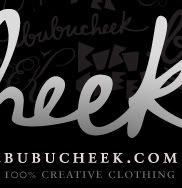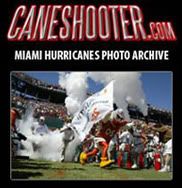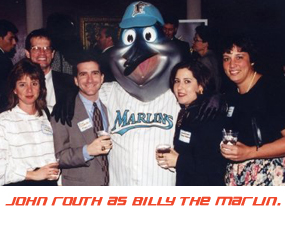 Part II: John talks about what it was like to be Billy the Marlin, how the C-A-N-E-S CANES chant started, the differences between Coach Johnson and Coach Erickson and much more! Click here to read Part I
Part II: John talks about what it was like to be Billy the Marlin, how the C-A-N-E-S CANES chant started, the differences between Coach Johnson and Coach Erickson and much more! Click here to read Part I
pC: How was it being Billy?
JR: It was more of a job. Being the Ibis and being the Maniac , it was fun! I had a little scooter, after I moved off campus. I moved off to Miller Drive and a lot of times I just put the costume on and took a ride out to campus and drove around in the scooter, I mean it was really fun, it really was great. I can’t even call it a job. And that was my attitude when I was in costume: if I was having fun, I figured everyone around me was having fun. So if I were in costume now, I’d probably be sitting here banging my head on this pole because I know people would laugh saying “Look he’s banging his head on the pole!” You know, so just doing crazy stuff, and like I said there were no rules. So now the ACC has rules for mascots and UM has certain things they want him to do and things he can’t do. But there were really no rules so I made up my own rules. I mean it was really a blast.
pC: So how long did Billy the Marlin last?
JR: I did 10 years with them ending in 2002.
pC: You didn’t do Burnie or anything else?
JR: No, I did do Freddy the Flamingo at the Hialeah race track. That was a little side job.
pC: So Billy wasn’t as fun? I guess the crowds there aren’t as big?
JR: Well the first year, until the strike of ‘94 we averaged about 40,000fans. When you look back on it, people blame Huizenga for dismantling the team in ‘97 but it was really the strike of ‘94, it really hurt baseball here because when they came back in ‘95-‘96 we were averaging 10,000 fans going from the 40,00 [fans] before. And even during the ‘97 season and even when Wayne [Huizenga] spent all this money to buy the team we were averaging 17-18k and we were in the wild card hunt and fighting Atlanta for the lead for most of the year. Then in September, here we have Alex Fernandez, a hometown boy, pitched on Friday night and Livan Hernandez, the Cuban defect, pitched on Saturday night. We had 17k on Friday night and 18k on Saturday night, and this was in early September in the middle of playoffs. I really think the strike hurt things more than Huizenga’s dismantling but he gets the blame for it. Being Billy was more of a job because we had the corporate sponsors, Major League Baseball had established the rules that mascots could only be on the field once per game so I’d do pre-game stuff, take the first inning off, because I’d been out for a half hour, do the corporate suites or whatever I had to do 2nd and 3rd innings, do my routine in the 5th inning, hit the stands in the 6th, take me out to the ball game in the 7th, hit another suite, it was very structured. And when the team was out of town, it was appearances at banks and other places. And I wasn’t able to travel and do the summer jobs like I wanted or I had done. It definitely became more of a corporate thing. I’d do 300 appearances outside of the games. Some were paid appearances, birthday parties and a few things, but the majority of it was corporate things which were part of the job. It was still fun to be in costume but it wasn’t as fun as doing the college games.
pC: There were stories in the papers about it how your time as Billy ended. It didn’t end in a good way?
JR: When John Henry bought the team, they were trying to get a stadium. He gave me a three-year contract, nice pay raise and the plan was that they were going send me to rotary breakfasts and stuff like that. I would jump from 300 to 600 appearances a year. One thing I was very proud of, is they did a community survey and Billy the Marlin had a positive rating of 98.7%. But my thought was who were those 1.3% because I want to go talk to them and I want to entertain them and change their mind. So they knew that getting me out in the public was going to be good but then on opening day, there was some tax on cruise lines, that Governor Bush nixed, and here I just signed some big contract and the whole plan went caput because of the Governor’s decision [cut the stadium funding] which was good for me because I was getting paid but didn’t have to do the work. But when the current ownership came in it was my last year under contract and even though I offered to take 50% pay cut and hand over any outside revenues because I kind of wanted to go out on my own terms, they didn’t want to go for it. It made the papers because I contacted an attorney and they let it leak to the press that I was getting ready to sue them, but I wasn’t. I went to the attorney asking what I could do. And I also had found out that John Henry’s part of the sale made them agree that they would pay one month severance for every year that a person was there. Well I was there for ten years but they didn’t offer me any severance because they say my contract had ended. I possibly could have sued them and I might have gotten maybe three to four months severance but I would have lost it paying attorney’s fees. So it wasn’t a pretty ending because I would have liked to have gone out on my own terms. That made me realize that it was a business.
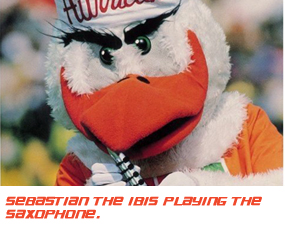
JR: Yeah, well I started doing it at baseball games when a player would hit a home run. I probably started doing it within the first year or two. Actually when I was at South Carolina at the baseball games I would spell out “Cocks,” so being the brilliant guy that I was, I thought C-O-C-K-S, C-A-N-E-S, that’s five letters!! So that’s kind of how I had done it, in South Carolina and I brought it down here. The baseball fans did it, and in football it was kind of hard to start. I would do it in the closed end zone and I’d get some response and over the years it would build up, but the first time I did it in the middle of the field it was the Notre Dame game, in ‘89. One versus two. The place [Orange Bowl] was packed. So, the electricity in the stadium was amazing that night. My whole family came down for the game. And my dad’s been to all sorts of sporting events for 50 years and he said he could feel his hair standing up. It was an amazing scene. It was the end of half time and it was almost like people didn’t leave their seats at half time. The band played because Notre Dame didn’t bring their band down. So when the Miami band finished there was still six or seven minutes on the clock and so I just walked out in the middle of the field and thought alright what am I gonna do? So I just started with the hands and I could hear it getting louder and louder and louder and I was kind of milking it and really spinning around and getting everyone in the stadium and it gives me goose bumps to think about it.
pC: It gives me goose bumps just hearing it!
JR: When I went into it, I kind of did like a little hop before and it was like the anticipation I could just hear the crowd roaring and the CANES! I remember my dad videotaped it and I could remember just thinking YES! Finally I realized that this is something big and so I did it a couple more times and it just got louder and louder and I realized okay we’ve got something here it’s not just going to be in the corner anymore it’s going be middle of the field. And even now when I hear the OOOOHHHH it gives me chills because it’s something that I started and that’s the legacy and it’s going to be a cheer that 50 years from now Miami will still do. It’s a great feeling.
pC: I don’t think many people know that you started it.
JR: Well, in truth, I was able to do it year after year after year. You know that’s one of the things that when they have student mascots, unless they have established some traditions, the character changes every year. And so, that’s one of the things that I’m really proud because you know we kept that going.
pC: So you started under Jimmy and you were there with Ericson as well. Was there a difference between the two? First talk about how they were as coaches and how they treated you and then maybe talk about it on a global scale, how did the program change? JR: I mean obviously you could tell that both of them loved doing what they were doing. They both treated me extremely well and I think a lot of it was because we were winning. It was like why change things if it’s working.
pC: So did you see a difference when Erickson came in? Like Leon Searcy said, “Erickson was given keys to a Porsche and basically told not to wreck it.” Did you see that? And then toward the end of Erickson’s tenure we started sliding, did you see a change in the program?
JR: Jimmy was more of a disciplinarian than Erickson and that might have been more of a philosophical difference that Jimmy wanted to really kind of control every aspect of the program and Dennis looked at it more like these guys are adults, in more of a professional manner instead of looking at these guys as kids. That’s one thing that bugs me about the thug UM image and all that. These were great kids. They may have danced on the field and we would tell you we were gonna kick your ass and then we’d go out and kick your ass and dance while we were doing it, but these were good guys, these were not criminals, these were very great kids. They were very flamboyant, we were winning. And Jimmy to some extent liked all that and Dennis came in and said why change it if it works. If that’s what the players want to do then let’s let them do it. So, there was a difference in maybe the attitude that Jimmy was a little more controlling but to this day I didn’t really see the any thug stuff and that stuff has always bugged me. It’s one of those things. My family came down to the game in ‘87, and the image was already starting to get there and South Carolina played Miami and there was a fight that happened during the game. And so we get back to the hotel and even my family was like you guys are a bunch of thugs and then when we watched the replay of the game it was a South Carolina player that started the fight and it was a South Carolina player that kicked one our guys who was on the ground. And so I just said: “if we are thugs then they’re thugs everywhere!” You know these are kids. There are things that are going happen on the field. They’re kids in a very intense whimsical situation. You can’t expect everyone to be just calm, cool, and collected and not blow a gasket occasionally, especially if being kicked in the head.
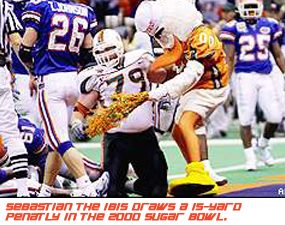
JR: I don’t know the actual rules but I know if a referee yells at you to get off the field you know you’ve done something wrong. I don’t think they’re allowed to do as much stuff on the field anymore but I don’t know if there’s a specific rule. You know the one time the Ibis wnet out onto the field in the Sugar Bowl, he got a penalty. They know that they can’t just go out and do whatever the hell they want, they have to be careful and make sure they don’t do anything to upset them.
pC: Another image I have is when you came out in with little sooner schooner.
JR: I still have that. That will probably end up in the hall of fame at some point.
pC: It was on fire, right?
JR: Yeah. What I did was I went to Toys ‘R Us and I bought a little wagon and I got three coat hangers and cut off a pillow case and made a top to it and I even put on the handle a horse’s head head from a stick. And on the bottom I put tin foil with a bunch of rags and soaked them with some lighter fluid. I was hoping to do it earlier in the game but we got up 20 to 7 and they scored late making it 20-14 so I had it hidden under the Orange Bowl. So we punted them inside their ten with a minute to go. They still had a chance to win the game and they were down on the open end and I stayed down on the closed end because I wanted to do this because I spent all this time making the thing. So this was right at the end of the game and Oklahoma fumbled inside the 10, we had the ball with 38 seconds left and had to just kneel down once. And so that’s when I lit it and came out pulling it and I had my number 1 jersey on and I was pulling the sooner and a friend of mine who was in the endzone said you could see it glowing and suddenly it caught fire on the edge and like in the cartoons the whole thing burned up and little pieces started dropping. As I ‘m walking across the field I’m kind of in the closed endzone just walking across to the 15 yard line and one of the players told me he was standing there at the other end and one of the referees started to the throw a flag and the other referee just came over and told him just forget it the game is over. I’ve got a photo it’s in the Hall of Fame.
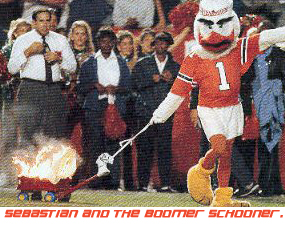
You know when I’m thinking up these things, I’m not thinking this is something people are going remember 20 years later but it’s kind of neat that those things are remembered and it’s kind of the allure of Hurricane football. People come up to me and remember the Houston game when we played [David] Klinger and I dressed up as the Grim Reaper and again it wasn’t something that I was really consciously thinking this is something big. I think I had seen a movie or something and I think it would be kind of cool to see the Ibis come out and point the finger and two Heisman contenders and so it fit that we killed his chances and so when I was doing it, I was just doing it to have fun but in hindsight it’s pretty neat that people remember all these years later.
pC: How did you think of these things? Was it just like random things that would pop in your head?
JR: I’d look at the opponent first and think of what would be appropriate. I think one time we played the Gators and I dressed up as the Crocodile Hunter guy and I remember coming out like in a safari hat and acting like I was going to capture a gator. Things like that when you think of something that’s appropriate for the team. When we played Texas in the Cotton Bowl I came out in a full cowboy outfit with a branding iron. Maybe in my warped mind I would come up with these ideas. I wanted to be very visual about it. I was a journalism major at South Carolina. I took photography classes and different things so I was always wanted to be visual in things that I did. Like when Vinny Testaverde was up for the Heisman the last game of the year he got hurt in the little scooter accident, so I had planned this: I had a complete Heisman outfit made. I got a beach ball and spray painted it gold so it would fit over the top of the head. I had an old pair of pants Shorty gave me that I spray painted gold, I got a jersey spray painted gold. We had worked it out where we had this little tractor at the stadium and so I was going to stand in the back, I even had the football painted gold, and most people think the pose is with the leg up but it’s this leg this way (demonstrating the Heisman pose) it’s actually a really difficult pose to hold and so I’m standing in the scooter riding around and so I was thinking the whole way how visual it was going be and ESPN showed that thing for weeks particularly after Vinny won the Heisman. So I always wanted to do things that were visual. It may not be the funniest thing but people will say “hey look the Ibis is dressed as the Heisman trophy!”
Come back tomorrow and read Part III of our interview with John Routh and see what he talks about his most memorable experiences, what it feels like to put on the Ibis costume and much more! Click here to read Part I

